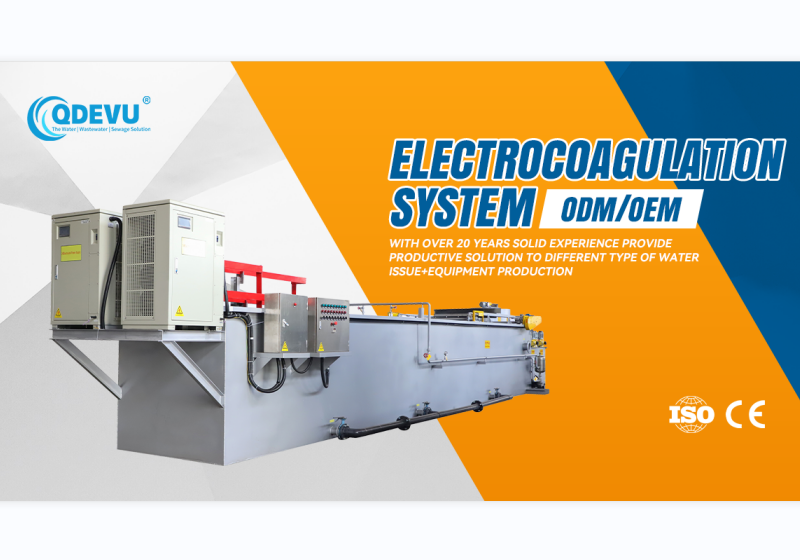Electro-coagulation Flotation System in Papermaking Wastewater Treatment
The papermaking wastewater can be roughly divided into: Pulping cooking liquor, Washing wastewater, Bleaching wastewater and Paper machine white water. And alkaline pulp cooking waste liquor, also known as "black liquor", is the main pollution source of pulp mills. Today, we'd like to share advanced treatment methods of papermaking wastewater, leyt's have a look.
Treatment methods of papermaking wastewater
In the advanced treatment of papermaking wastewater, physical and chemical methods have the advantages of fast treatment and good treatment effect. The commonly used methods include Advanced Oxidation, Flocculation and Sedimentation, Membrane Separation and Adsorption, etc.
Advanced Oxidation Process
Advanced Oxidation Processes (AOPs), also known as deep oxidation technologies, are a new technology developed in the 1980s to treat refractory organic pollutants.
Under the action of oxidants, electricity, sound, light irradiation, catalysts, etc., it produces a strong oxidation ability of • OH,through the addition, substitution, electron transfer, bond breaking, ring opening, and other actions between OH and organic compounds, the refractory macromolecular organic compounds in wastewater are oxidized and degraded into low toxic or non-toxic small molecular substances, and even directly decomposed into CO: and H: O, achieving the goal of harmless treatment.
This technology has the advantages of fast reaction speed, high treatment efficiency, thorough destruction of toxic pollutants, no secondary pollution, wide application range, and easy operation. It has been widely used in the treatment of toxic and refractory industrial wastewater such as Pharmaceutical, Fine Chemical, Printing and Dyeing Organic Wastewater, and has gradually become a hot spot in the research of refractory wastewater treatment.
According to the different ways of generating free radicals and reaction conditions, they can be divided into Fenton type oxidation method, Supercritical water oxidation method, Photocatalytic oxidation method, Ultrasonic oxidation method, Electrocatalytic oxidation method, Ozone oxidation method, and Wet air oxidation method.
Membrane Separation Process
Membrane separation method uses a special semi permeable membrane to separate solute and solvent, allowing some solute in one side of the solution to permeate through the membrane or solvent, thereby achieving the purpose of separating solvent.
Use a system (MBS) that combines traditional two-phase anaerobic process (BS) with membrane separation technology to treat papermaking black liquor configuration wastewater.The results show that the COD removal rate of the system can reach 73.1, higher than that of the BS system (48.6%), and superior to the BS system in terms of anaerobic sludge activity and operational stability; When the COD load is 6kg • (m3 • d) - 1, the acidification rate of MBS is 20.1%, and the acidification level is 7.5%, slightly better than that of BS system (7.0% and 5.0%, respectively).
Flocculation Sedimentation Process
Flocculation precipitation method is a method for removing suspended and colloidal macromolecular mass pollutants from water through a series of actions of polymerization products formed by flocculants. This method has been widely used for the tertiary treatment of pulp and paper wastewater.
Under the optimal operating conditions, continuous treatment of papermaking wastewater using flocculation electroflotation can reduce the COD and cr content of the wastewater from 1416 mg/L to 48.9 mg/L.
The QDEVU Electrocoagulation System is a powerful combination of electrolysis, flocculation, and air flotation techniques designed to effectively remove a wide range of pollutants from wastewater. It is capable of removing COD, BOD, suspended solids, grease, turbidity, chromaticity, heavy metal ions, calcium, and magnesium ions, among others, and can greatly enhance the B/C value of biochemical treatment. Through electrolytic flocculation, this system can effectively coagulate and precipitate colloidal and suspended impurities, as well as oxidize and reduce a variety of pollutants in the water.
Because of its versatility, the QDEVU Electrocoagulation System can be extensively applied across various wastewater treatment industries, including electroplating, car washing, textile bleaching, paper mills, slaughterhouses, food and beverage factories, oil refineries and fields, pharmaceuticals, mining, waste leachate, agriculture, painting, dyeing, pigments, sewage cooling towers, wood processing, travel and scenic areas, and even for sewage purification at the bottom of ships and port catchment areas.
Visit www.evuchina.com for more informations!
#QDEVU #WATERTREATMENT #WASTEWATERTREATMENT #SEWAGETREATMENT #SEWAGEWATERTREATMENT #WATERFILTER #WATERFILTRATION #SLUDGETREATMENT #SLUDGEDEWATERING



